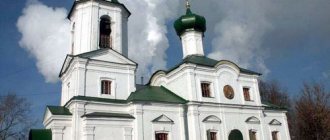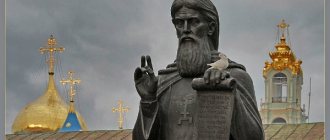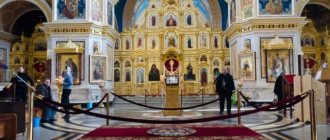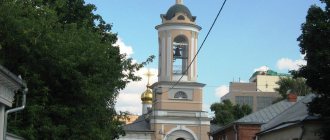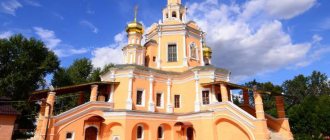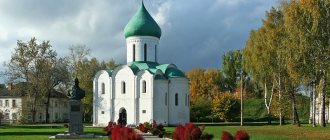| Sorrow Church. March 4, 2017 |
Moscow Church in the name of Florus and Laurus (in honor of the icon of the Mother of God Joy of All Who Sorrow) on Zatsepa, in Kolomenskaya Yamskaya Sloboda
(Moscow diocese)
- Thrones: icons of the Mother of God “Joy of All Who Sorrow” (main), Flora and Laurus (chapel), Peter and Paul (chapel)
- Address: Russia, Moscow, Dubininskaya street, 9/3 building 1
- Directions: metro station "Paveletskaya"
- Official site:
- On the map: Yandex.Map, Google map
The wooden church in the name of the holy martyrs Florus and Laurus in Kolomenskaya Yamskaya Sloboda has been documented since 1625.
But it is also known that the church existed before the Romanovs, since it received a rogue, and from ancient times was called “Flora and Lavra in the Yamskaya Sloboda.” Since 1628, the main altar of the temple was for some time dedicated to the holy apostles Peter and Paul. In 1727 there was a chapel in the name of St. Nicholas. Later, the throne in honor of the icon of the Mother of God “Joy of All Who Sorrow” became the main one, and the St. Nicholas chapel was abolished. According to tradition, the temple continued to be called Floro-Lavra.
In 1738 the church burned down. On October 24, 1739, priest Sergius Ivanov and his parishioners received permission “to rebuild the church with the designated chapel instead of the one that burned down.”
In September 1745, a church with a chapel was built in the name of the holy apostles Peter and Paul.
| Church of Florus and Laurus on Zatsepa in Moscow. |
The modern church building was built in 1778.
On April 8, 1829, the priest and parishioners turned to the Moscow Spiritual Consistory with a request “to allow the Sorrowful Church in the Yamskaya Kolomenskaya Sloboda, due to its dilapidation, to be built again in stone, with the addition of a chapel on the north side in the meal in the name of the holy martyrs Florus and Laurus.” . However, the Commission for Buildings in Moscow did not approve the plan provided at that time and permission was not received from the Consistory.
On July 31, 1833, at the Church of Sorrows, in the Yamskaya Kolomenskaya Sloboda, priest Alexei Ivanov with the clergy and parishioners turned to His Eminence Philaret, Metropolitan of Moscow and Kolomensk with a special petition. They asked for permission to rebuild a stone church building instead of the present parish church, which was falling into disrepair. At the request, the bishop was presented with a plan by the architect, Academician Shestakov. The plan showed a proposed church building with the addition of a refectory, on the north side of the chapel in the name of the holy martyrs Florus and Laurus. On November 12, 1833, it was decided to issue a temple-created charter to petitioners from the Consistory.
In 1839, a new church building was built. The currently existing altars were built in it: the main one - in honor of the icon of the Mother of God “Joy of All Who Sorrow”, and the chapels - in the name of Sts. App. Peter and Paul and Sts. mchch. Flora and Laurel.
Subsequently, partial alterations and improvements were undertaken to the temple building built in 1839. In 1861, the main quadrangle of the temple was dismantled, and in 1862, the current main church was built and consecrated in honor of the icon of the Mother of God “Joy of All Who Sorrow.”
In 1908, external repairs of the temple were carried out. Inside the temple, the iconostases and wall paintings were restored. The domes on the bell tower and the church were re-gilded. After repairs, the temple was re-consecrated.
In 1909, western extensions were added to the temple.
Since 1924, utensils, icons and shrines from closing Moscow churches, including from the bombed Cathedral of Christ the Savior, were taken to the temple.
In 1937, the rector of the temple was arrested and until mid-1938, services in the temple were held only sporadically. In the second half of 1938, the temple was officially closed and the building was transferred to the workshop of a metallographic and engraving factory, partitions and three interfloor ceilings were erected, the wall paintings were painted over and partially destroyed. The dome above the main volume of the church was dismantled.
In 1957, the upper tiers of the bell tower were demolished, and the crushed red brick of the church bell tower was used to strew the paths to prepare Moscow for the celebration of the Festival of Youth and Students.
Since 1960, the temple building has been recognized as an architectural monument and placed under state protection, but continues to be used for industrial purposes. In 1978, research and design work on the restoration of the temple began. By 1985, a project for the restoration of the bell tower and the main building was created, but the work was not carried out.
The decision to transfer the temple to the Russian Orthodox Church was made on January 8, 1991. One of the production workshops was cleared for religious services. On Easter, April 6, 1991, the first service took place. Production was finally stopped only in August of the same year due to violations of environmental and fire regulations. The area around the temple was cleared of aluminum waste. Under the altar of the chapel of the holy martyrs Florus and Laurus, about two meters of earth was removed: the factory dumped production waste into holes under the foundation.
By 1997, the drum and dome above the dome of the church and the upper tiers of the bell tower were restored, and other restoration work was carried out. The bell tower with the dome has been recreated. Before the destruction, the bell tower of the temple housed a bell weighing 13 tons. Now the largest bell weighs 5.3 tons. The facades of the temple were decorated with mosaic icons.
The temple was called Zatsepsky because it was built at the Moscow customs house behind the chain
The Temple of Florus and Lavra on Paveletskaya is rich not only in its decoration, but like all ancient churches - in history and events. The name “on Zatsep” has been attached to it since the time when the border of Moscow and customs passed through the territory of the Yamskaya Kolomenskaya Sloboda.
Nikolay Teleshov
writer
Writer Nikolai Teleshov said:
“...On Zatsepa, in a spacious square, there was a large temple named after Florus and Laurus, to whom patronage over horses was attributed. And every year, in mid-August, this entire large square in front of the church was filled with hundreds of horses. Most are ceremoniously decorated with rag flowers in their manes and bright ribbons woven into their tails. They are held by the reins of smart grooms and coachmen in anticipation of the prayer service, which was celebrated solemnly in the square at the end of the festive mass...”
A chain was stretched across the street, and after checking the cargo at customs, special people removed the chain and let the carts cross the border.
After 1722, the borders of Moscow expanded, customs moved out, but the streets, squares and passages were called Zatsepsky, and the Church of Flora and Laurus was on Zatsep. After the October Revolution, the street was renamed Dubininskaya in honor of the revolutionary Ivan Dubinin.
This is what the Temple of Florus and Laurus on Paveletskaya looks like today, first built more than five centuries ago
In one of the Russian beliefs, Florus and Laurus came out of the well alive
In Rus' there were many beliefs associated with the martyrs Florus and Laurus. According to one of them, saints dug wells in the Oryol region.
One day the well collapsed and the brothers were buried alive underground. Water began to seep out of the collapse and a large puddle formed.
A thin horse came to her to drink - she recovered and grew fat.
The fame of the healing spring spread throughout the area. The men began to drive the sick and old cattle to a watering place. Having drunk the water, the cattle rose and recovered.
Then the locals decided to dig a well in this place, and a miracle happened. Flor and Laurus were found alive and unharmed with shovels in their hands.
Having healed the priest's son, Florus and Laurus converted three hundred builders of the pagan temple to Christianity.
In the hagiographical writings, Florus and Laurus were siblings who believed in Christ from their youth. They lived in Byzantium in the 2nd century, and then moved to Illyria.
The brothers worked as stonemasons; Christians Maxim and Proclus taught them this craft, and at the same time the godly faith. The ruler of Illyria once sent Florus and Laurus to build a pagan temple in a neighboring region.
The brothers worked hard, distributed the money they earned to the poor, and they themselves prayed and observed strict fasting.
One day the son of the local priest Mamertine approached the construction site. A fragment of stone bounced off and hit him in the eye and seriously injured him. The holy brothers promised the angry Mamertine that they would heal his son. They took the young man to themselves, prayed over him and taught him faith in Christ.
The young man confessed Christ as the True God and his eye was healed.
Seeing such a miracle, the priest also believed in the Lord with all his heart.
Many builders became Christians after the miracle occurred. And when the temple was completed, they gathered, crushed and burned the pagan idols. And in the eastern part of the new temple they placed a holy cross.
Having learned about this, the ruler ordered the priest Mamertine and his son and all the Christians, and there were three hundred souls at the construction site, to be burned at the stake. Flora and Laurus were sent to Illyria, where they were thrown alive into a well and covered with earth.
Many years later, the relics of the holy brothers were found incorrupt and transported to Constantinople.
The life mentions that immediately after the discovery of the holy relics of the martyrs Florus and Laurus, the death of livestock stopped.
In Rus', these saints were considered the patrons of horses. A legend came from the Balkans that the brothers were trained to control horses by the Archangel Michael himself. It was customary to depict holy martyrs with horses on icons.
The history of the Temple of Florus and Laurus passes through more than five centuries
For the first time in historical documents, a wooden church is mentioned, built in Kolomenskaya Yamskaya Sloboda in honor of Saints Florus and Laurus in 1625.
However, it is also known that the clergy of the church received payments from the state treasury even before the Romanov dynasty came to power, until 1613.
In 1628, the main altar was reconsecrated in honor of the apostles Paul and Peter, and after a while in the name of the icon of the Mother of God “Joy of All Who Sorrow.”
The temple is already traditionally called Floro-Lavrovsky.
A year earlier, there was a chapel of St. Nicholas, but later the chapel was abolished.
The church burned down in 1738, but a year later priest Sergius and the parish received permission to erect a new building. Six years later, construction was completed, with the chapel of the Holy Apostles Peter and Paul.
In 1829, the parish submitted a petition to the Moscow Consistory for the construction of a new stone church with the addition of a refectory in place of the dilapidated wooden one, but was refused.
Ceiling painting in the Temple of Florus and Laurus
The priest of the church Alexy and the clergy submitted a second petition for the construction of a stone building in July 1833, but now to the Metropolitan of Moscow and Kolomna.
When he reviewed the application, he approved the construction plan and issued a permit.
The construction of a new stone structure with three altars was completed in 1839. The main altar is named after the icon of the Mother of God “Joy of All Who Sorrow”, the side chapels are named after the apostles Peter and Paul, and the holy martyrs Florus and Laurus.
In 1861-62, the main quadrangle of the temple was dismantled, the building was rebuilt into the current Church of the Icon of the Mother of God.
In 1909, external repairs and internal restoration work were carried out. Iconostases and wall paintings are being updated, the gilding of the domes is being changed, and western extensions are being added.
A plaque on the wall of the temple, indicating that it belongs to the architectural monuments of the city of Moscow
Long-awaited restoration
Research and design studies for the restoration of the temple began back in 1978. By 1985, a plan for the restoration of the bell tower and the main building appeared, but its implementation began only ten years later. The Patriarchate of the Russian Orthodox Church received the building “in unsatisfactory technical condition” and, by decision of the City Council, had to carry out repair and restoration work at its own expense [8]. Recovery was slow and interrupted many times.
In 2015, the church was included in the city program for supporting cultural heritage sites. The city provided the Patriarchate with a targeted subsidy. The work took a year and a half - from June 2015 to December 2016.
The restoration affected all elements of the building:
- facade - the dome and cross, the light drum, the rotunda and porticos, the northern and southern porches (including stone steps) were updated, the stucco decoration was recreated, protective plaster was applied;
- dome - a unique system of wooden rafters was recreated, hydro- and vapor barrier and insulation of the brickwork of the vault were carried out;
- interior - most of the wooden parts in the main entrance and vestibule were replaced, in the temple itself floors were made of stone slabs (instead of wooden covering);
- engineering systems - water and heat supply to the building has been organized, electricity and telephony have been established, domestic sewerage has been installed, and lightning protection has been installed.
The Moscow government recognized that all work was carried out at a high professional level, and awarded the project leaders with an award from the Moscow Restoration 2016 competition. Thus, the restoration of the Temple of Florus and Laurus, which formally began almost 40 years ago, was completed.
The time of Soviet power became black in the history of the Temple of Florus and Laurus
After the October Revolution, persecution of the Orthodox Church began. Temples were destroyed, property was stolen, clergy were subjected to repression.
The Church of the Holy Martyrs Florus and Laurus, located on the outskirts of Moscow, was equipped as a warehouse for church utensils. Shrines were brought here from destroyed churches, including from the Cathedral of Christ the Savior blown up by the Bolsheviks.
In 1922, the warehouse itself was expropriated.
The seizure list contains twenty-eight poods, twenty-four pounds, sixty-six spools of confiscated property.
The rector of the church, Archpriest Nikolai, was arrested for “anti-Soviet agitation” in 1933, and in 1937 he was shot.
In 2000, Father Nikolai Vinogradov was canonized by the Russian Orthodox Church.
1950 became a black year in the history of the temple. The head was removed from it and the dome was blown up. A metallography workshop was set up here for the production of stamp products.
In 1960, the building was recognized as a historical heritage and architectural monument and placed under state protection. But this did not stop the Soviet government from using the temple for production purposes.
Interior of the Temple of Florus and Laurus
On January 8, 1991, a decision was made to transfer the building to the Russian Orthodox Church. One of the production workshops is cleared for worship, and on April 6, Easter, the first liturgy is proclaimed to the sound of fans and working machines.
Production was curtailed in August of the same year due to violations of fire and environmental standards. Waste from stamp production was poured directly under the foundation of the temple. Under the altar of the holy martyrs Florus and Laurus, more than two meters of contaminated soil had to be removed.
Wall painting in the temple on Zatsepa
In 1997, the drum and dome were restored, a dome was erected over the dome, and restoration work was carried out. The upper tiers of the bell tower are being completed, and the facades are being decorated with mosaics.
Now the temple has three altars. The main one is the icon of the Mother of God “Joy of All Who Sorrow”, a chapel in the name of the apostles Peter and Paul and in honor of the holy martyrs Florus and Laurus. The shrine of the temple is an ark with the relics of 38 saints of God and church relics. The church traditionally hosts a Sunday school.
Used sources
- St. Muchch. Flora and Lavra // Lives of saints revered by the Russian Orthodox Church, as well as revered by the Greek Church, South Slavic, Georgian and locally revered in Russia. — No. 7–8: July — August / D.I. Protopopov. — M.: D.I. Presnov, 1885. - pp. 289–291.
- Romanyuk S.K. Lanes of old Moscow. Story. Architectural monuments. Routes. M., 2021. pp. 259–260.
- Tolstoy L.N. Full composition of writings. — T. 12: War and Peace. T. 4. - M.: Khudozhestvennaya literatura, 1940. - P. 47–48.
- TSGAM: F.179. Op. 20. D. 2570. L. 20.
- Decision of the executive committee of the Moscow City Council of Workers No. 1016 of May 19, 1940. TSGAM. F. R-150, Op. 1, D. 623, L. 114.
- Architectural monuments of Moscow under state protection. Moscow, 1980. P. 68.
- Decision of the executive committee of the Moscow City Council of People's Deputies No. 1225 of June 22, 1989. TSGAM: F. R-150, Op. 1, D. 6430, L. 210–211.
- Decision of the executive committee of the Moscow City Council of People's Deputies No. 27 of 01/08/1991. TSGAM: F. R-150, Op. 1, D. 6627, L. 368–369.
Documents provided by the Main Archival Department of the city of Moscow.
The temple is within walking distance from the metro and is open daily
Divine services in the temple are held daily:
In the morning - Liturgy at 8 o'clock, in the evening - Vespers and Matins at 17 o'clock. On holidays and Sundays - two Liturgies at 7 and 10 o'clock, All-night vigil at 17 o'clock the day before.
The official website of the Temple of Florus and Laurus is currently under construction
The rector of the temple is Acting Archpriest Grigory Belous.
The temple website is currently under development.
The Flora and Lavra Temple is located a two-minute walk from the Paveletskaya metro station, along Dubininskaya Street, building 9/3, building 1.
By leaving a comment, you accept the user agreement
Popularity in Rus'
Flora and Lavra were highly respected by peasants and coachmen. On the day of remembrance of the saints, they did not work on the horses; they fed them to the full, bathed and cleaned them. Housewives baked special cookies with the image of a horse's hoof. The horses were decorated with flowers and ribbons and led to the church, where the priests sprinkled them with holy water. There are well-known Russian sayings: “I begged Frol and Laurus - expect good things for the horses”; “Frol and Laver are as good as a workhorse” [2].
People's love for these saints can also be judged from fiction. For example, the prayer of the hero of the epic novel “War and Peace,” soldier Platon Karataev, sounded like this: “Lord, Jesus Christ, St. Nicholas, Frol and Lavra, Lord Jesus Christ, St. Nicholas! Frol and Lavra, Lord Jesus Christ - have mercy and save us! - he concluded, bowed to the ground, stood up and, sighing, sat down on his straw” [3]. Another example from the classics, already Soviet: the priest Father Fyodor, a character in the novel “The Twelve Chairs” by Ilf and Petrov, served in the Church of Florus and Laurus.
But the main indicator of the popularity of saints is the number of buildings bearing their name. According to some data, at the beginning of the 20th century in Russia there were about 250 chapels, churches and temples consecrated in their honor or with chapels of Florus and Laurus. There were five of them in Moscow alone:
- two with chapels - the Church of the Three Saints on Kulishki (Maly Trekhsvyatitelsky Lane, building 4/6) and the Church of the Life-Giving Trinity at the Ermakovskaya almshouse (Korolenko Street, building 2/23; currently inactive);
- three named - the Church of Flora and Lavra at the Ermakovsky Technical School (Prechistenskaya embankment, building 11), the Church of Flora and Lavra at the Myasnitsky Gate (destroyed in 1935) and the Church of Flora and Lavra on Zatsepa, in Zamoskvorechye (Dubininskaya street, building 9, building 1).
There is a legend that the Church of Florus and Laurus stood near the walls of the Kremlin, which is why the gate was called Frolovsky. The church was allegedly moved to Myasnitskaya Sloboda on the orders of Ivan the Terrible, and in the middle of the 17th century an icon of the Savior Not Made by Hands was placed above the gate, and Tsar Alexei Mikhailovich ordered to call them Spassky. And from the church in Myasniki Moscow, Frolov Lane remained as a memory.


